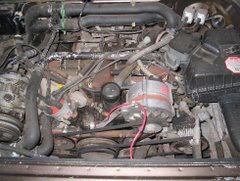
This unusual-looking three-wheeled vehicle is a Citroen (hmmm, Blogger apparently can't handle umlauts) kit car called the Lomax. These street-legal cars are usually built with an internal combustion engine, but this version is all-electric -- thus the green name and shade! Green also happens to be Methacton's trademark color.
The car is powered by a three phase AC induction motor, which gives it the capacity for regenerative braking (as in the Prius and other hybrids, energy captured from the braking process is used to recharge the batteries). The car body is fiberglass and having three wheels instead of four helps reduce both weight and friction to make it more efficient. It is also speedy, having achieved a top speed of 81 mph.

As you may recall from my account of its breakdown, our Dodge EV and most electric car conversions utilize an auxiliary 12-volt battery to power electrical functions in the vehicle other than the motor. The Lorax uses this onboard solar panel to keep that 12-volt DC battery charged. Steve remarked that it is highly functional -- once, when, they took it off for repairs, the DC battery went dead on them soon thereafter! I'd love to add that feature to the Vanagon.
When I'm exhibiting the Colt I am always asked about putting solar panels on it to charge the batteries. The reality is that -- because solar generation of electricity is still a rather inefficient process -- the extra miles-per-charge you might get from carrying around solar panels would not be worth the cost and added weight. (Maybe when this technology is widely available.) It is possible, however, to use a solar array to generate the power that charges the batteries -- and that's what the MECC has done.
When I'm exhibiting the Colt I am always asked about putting solar panels on it to charge the batteries. The reality is that -- because solar generation of electricity is still a rather inefficient process -- the extra miles-per-charge you might get from carrying around solar panels would not be worth the cost and added weight. (Maybe when this technology is widely available.) It is possible, however, to use a solar array to generate the power that charges the batteries -- and that's what the MECC has done.
 This 1-kW solar array, mounted on the roof of the Lorax's garage, went online in April and has already generated over 500 kW of energy -- some of which has gone to charge the Lorax, and the rest into the school's system.
This 1-kW solar array, mounted on the roof of the Lorax's garage, went online in April and has already generated over 500 kW of energy -- some of which has gone to charge the Lorax, and the rest into the school's system.  MECC's members didn't just raise funds for this system -- they were responsible for installing every bit of it except for the final electrical wiring, which was done by a professional electrician. They mounted the panels on the roof and the inverter and kW meter above. I regret that I failed to photograph the students who came out on a hot August afternoon to show off their car -- they all spoke very knowledgeably and enthusiastically about the vehicle and their pride in their accomplishments is well-deserved! Here's a photo of the team that took the Lorax to its last competition, the 21st Century Automotive Challenge back in June, where it won first place overall based on braking, acceleration, autocross performance and efficiency.
MECC's members didn't just raise funds for this system -- they were responsible for installing every bit of it except for the final electrical wiring, which was done by a professional electrician. They mounted the panels on the roof and the inverter and kW meter above. I regret that I failed to photograph the students who came out on a hot August afternoon to show off their car -- they all spoke very knowledgeably and enthusiastically about the vehicle and their pride in their accomplishments is well-deserved! Here's a photo of the team that took the Lorax to its last competition, the 21st Century Automotive Challenge back in June, where it won first place overall based on braking, acceleration, autocross performance and efficiency. Thanks to Steve, Daniel, Ian, Billy and Chris for a very informative and enjoyable tour.
Thanks to Steve, Daniel, Ian, Billy and Chris for a very informative and enjoyable tour.Look for an update on Friday's class later this weekend!







No comments:
Post a Comment